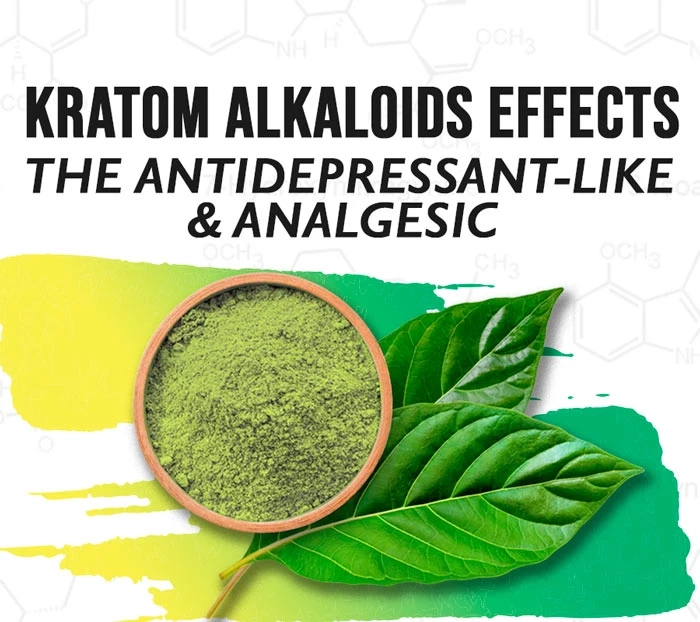The Antidepressant-Like and Analgesic Effects of Kratom
Mitragyna speciosa (“kratom”), employed as a traditional medicine to improve mood and relieve pain, has shown increased use in Europe and North America. Here, the dose-dependent effects of a purified alkaloid kratom extract on neuronal oscillatory systems function, analgesia, and antidepressant-like behaviour were evaluated and kratom-induced changes in ΔFosB expression determined. Male rats were administered a low or high dose of kratom (containing 0.5 or 1 mg/kg of mitragynine, respectively) for seven days. Acute or repeated low dose kratom suppressed ventral tegmental area (VTA) theta oscillatory power whereas acute or repeated high dose kratom increased delta power, and reduced theta power, in the nucleus accumbens (NAc), prefrontal cortex (PFC), cingulate cortex (Cg) and VTA. The repeated administration of low dose kratom additionally elevated delta power in PFC, decreased theta power in NAc and PFC, and suppressed beta and low gamma power in Cg. Suppressed high gamma power in NAc and PFC was seen selectively following repeated high dose kratom. Both doses of kratom elevated NAc-PFC, VTA-NAc, and VTA-Cg coherence. Low dose kratom had antidepressant-like properties whereas both doses produced analgesia. No kratom-induced changes in ΔFosB expression were evident. These results support a role for kratom as having both antidepressant and analgesic properties that are accompanied by specific changes in neuronal circuit function. However, the absence of drug-induced changes in ΔFosB expression suggest that the drug may circumvent this cellular signaling pathway, a pathway known for its significant role in addiction.
Introduction
Mitragyna speciosa, commonly referred to as kratom, is a tree species that is native to Southeast Asia and it has been used by individuals for centuries both recreationally and medicinally to improve mood and manage acute and chronic pain (Singh et al., 2016; Ismail et al., 2019). However, the increase of kratom sales across Europe and North America have resulted in growing concerns over its safety, with several European countries and states within the United States banning the plant or instituting age restrictions in its use (Cinosi et al., 2015). Despite these restrictions, it is estimated there are several million users of kratom (Henningfield et al., 2018). Consumption of kratom leaves has been reported to have dose-dependent effects, in that lower doses have been found to induce mild stimulant-like effects and higher doses have been found to induce opioid like analgesic effects (Kruegel and Grundmann, 2018). These outcomes of ingesting the plant material have historically been attributed to only two alkaloids that are typically present within the kratom leaf material, namely mitragynine and its derivative 7-hydroxymitragynine (7-HMG), however it is well established that there are at least 40 other alkaloids that accumulate within the plant, albeit in various amounts (Prozialeck et al., 2012; Eastlack et al., 2020). Strikingly, almost nothing is known about the biological properties of these other alkaloids, or of the combined biological effects of the plant as a whole.
The alkaloid profile observed within kratom is dominated by the class of compounds known as the monoterpenoid indole alkaloids, of which mitragynine and 7-HMG are the most studied examples. Both alkaloids have been found to activate the mu-opioid receptor (MOR), however unlike many other MOR agonists, they are ß-arrestin sparing (Kruegel et al., 2016; Ismail et al., 2019). For this reason these alkaloids have been termed “atypical opioids” (Adkins et al., 2011; Kruegel et al., 2019), and as ß-arrestin signaling has been shown to mediate opioid-induced tolerance and side effects such as respiratory depression, it is believed that kratom may offer an analgesic alternative (Takayama et al., 2002; Kruegel et al., 2016; Ismail et al., 2019).
Behaviours are highly coupled to neuronal oscillations (Buzsáki and Draguhn, 2004; Buzsáki et al., 2013), rhythmic neuronal population activity that is critical to regional communication (Fries, 2005; Barardi et al., 2014). These oscillations have been linked to neuropsychiatric disorders such as addiction and depression (Fitzgerald and Watson, 2018; Theriault and Perreault, 2019; Zhu et al., 2019; Thériault et al., 2021), as well as drug responses (Reakkamnuan et al., 2017; Manduca et al., 2020), and thus may serve as useful biomarkers of disease states or establishing the therapeutic efficacy of novel drugs. Although there is less known about the role of neuronal oscillations in the context of analgesia, high frequency cortical oscillations are thought to be involved in the perception of pain (Whittington et al., 1998; Croft et al., 2002). For instance, morphine-induced frequency-specific alterations in oscillatory activity in brain regions such as the NAc and VTA are well known (Reakkamnuan et al., 2017; Ahmadi Soleimani et al., 2018), as well as in the cortex (Liu et al., 2005; Zuo et al., 2007). It is therefore intriguing that although there is some evidence for analgesic and antidepressant properties of kratom alkaloids (Matsumoto et al., 2004; Takayama, 2004; Kumarnsit et al., 2007a; Kumarnsit et al., 2007b; Sabetghadam et al., 2010; Idayu et al., 2011; Grundmann, 2017), the impact of these alkaloids on the neuronal oscillatory activity in the brain is lacking. Two studies examining the neurophysiological effects of mitragynine in rats did, however, demonstrate frequency-specific changes in cortical oscillatory power (Yusoff et al., 2016; Thériault et al., 2020) with no effects in other regions including the VTA, NAc, thalamus, amygdala, or hippocampus (Thériault et al., 2020).
These findings suggest that kratom-induced behavioural changes will be accompanied by region-specific alterations in neurophysiological circuit function. Therefore, to better understand this link, this study evaluated the dose-dependent effects of a purified alkaloid isolate from kratom on neuronal oscillatory activity in various brain regions in rats following acute and 7 days of administration. The antidepressant and analgesic effects of the extract were also determined at both time points, as well as the ability of the isolate to induce ΔFosB expression, a putative molecular switch for addiction.
Materials and Methods
Animals
Adult male Wistar rats (Charles River, QC) weighing approximately 300–350 g at the start of the experiment were used. Animals were housed in a temperature-controlled colony room, maintained on a 12-h reverse light/dark cycle (0700 h lights off; 1900 h lights on) with unrestricted access to food and water available ad libitum. Animals were handled daily for a minimum of 7 consecutive days prior to the beginning of the experiment. Electrophysiological and behavioural testing was always conducted during the dark phase of the day/night cycle. An extra cohort of animals were added to increase sample size for the behavioural studies. All animals underwent identical behavioural procedures. No group differences in animals that underwent the same treatments was evident between the two cohorts and so animals were pooled. All procedures were approved by the Animal Care Committee of the University of Guelph and followed the guidelines of the Canadian Council on Animal Care.
Plant Material and Growth Conditions
Mitragyna speciosa (Korth.) Havil were obtained from Dad’s Greenhouse, Ohio, United States, and imported to the University of Guelph as 6–18″ saplings. Trees were maintained in growth chambers with a 16-h photoperiod (175 µmol m−2s−1; mixed cool white and incandescent bulbs) and a day/night temperature regime of 28°C/26°C, with a constant relative humidity of 80%. Plants were grown for a minimum of 4 months in a 2:1:1 (v/v) mixture of coco coir (Millennium soils Coir):perlite (Therm-o-rock East Inc.):turface (Turface Athletics) before harvesting material. The plant material was identified and authenticated by Dr. Carole Ann Lacroix and a voucher specimen (No. 102033) was deposited at the Ontario Agricultural College Herbarium in Guelph, Ontario, Canada.
Alkaloid Extraction and Preparation
Mature leaf tissue from Mitragyna speciosa plants were dried at 50°C for 48 h and 100 g of this material was extracted with 2 L of an acetic acid solution (0.5 M) at 80°C for 30 min. The crude extract was filtered (0.22 µm PTFE) and then passed through a 60 ml column containing polyvinylpyrrolidone (PVPP, 110 µm particle size, Sigma-Aldrich) to remove any polyphenolic compounds. The crude Kratom extract was sequentially chromatographed over 50 ml of Diaion HP-20 resin (Supelco) equilibrated with distilled water and the reversed-phase column was then washed with 20% (v/v) methanol before elution with 100% methanol followed by methanol/ethyl acetate (50:50 v/v). The recovered alkaloid fractions were pooled and reduced to a volume of 200 ml on a Rotary Evaporator (RE-200AA) at 70°C. The isolate was then loaded onto an ion exchange resin (AmberChrom 50WX2, 200–400, Sigma Aldrich) and washed with 500 ml of acetic acid in ethanol (0.025 M), followed by 250 ml of 100% ethanol. Alkaloids were eluted with 340 ml of 2.8 M ammonium hydroxide in ethanol and then brought to final volume of 150 ml. This purified alkaloid extract was subjected to phase separation with chloroform (300 ml). The organic layer was extracted and reduced to dryness, in vacuo, and resuspended in 10 ml of hydrochloric acid (0.2 M). After complete resuspension of the alkaloid extract, the pH was brought to 5.0 with NaOH and adjusted to 1.0 mg/ml of mitragyine equivalents, accordingly.
Instrumentation and Alkaloid Analysis
Ajmalicine (Sigma) and mitragynine, 7-hydroxymitragynine, paynantheine, speciogynine, mitraphylline, speciociliatine (Cayman Chemicals) were used as external standards for quantification on the basis of peak area revealed by HPLC analysis as described below. Alkaloids fractions were analyzed using an Agilent 1,260 Infinity liquid chromatography system equipped with a reversed-phase Kinetex EVO C18 100Å column (150 × 4.6 mm, 5 µm). Chromatographic separation of kratom alkaloids were achieved using a binary gradient with ammonium bicarbonate buffer (5 mM pH 9.5; A) and acetonitrile (B), starting with 70% solvent A transitioning to 70% solvent B over the course of 17 min at a flow rate of 1.5 ml/min. Alkaloids were quantified at 226 nm. The alkaloids fractions 3 (3-isoajmalicine) and 10 (corynantheidine) eluted at 8.12 and 14.67 min, respectively, and were subsequently collected. Approximately 0.3 mg of each compound were evaporated to dryness, resuspended in deuterated chloroform, and analyzed using 1H NMR. NMR spectra were collected on a Bruker AVANCE III 600 MHz spectrometer equipped with a 5 mm TCI cryoprobe. The sample temperature was regulated at 298 ± 1 K.
Read more about The Antidepressant-Like and Analgesic Effects of Kratom
0


